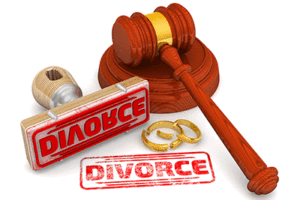Historical Controversy of Divorce in Ireland
In contrast to the contemporary divorce processes, divorce was not permitted in court, instead, it was granted in the parliament, throughout the late seventeenth century. Nonetheless, due to a reinvigorated constitutional ban on divorce in 1937, there was not any divorce procedure, neither in Parliament nor in courts in Independent Ireland. Legislation permitting legal divorce in Ireland was not adopted until 1995, with the first divorce issued in the following year.
 The route to legalizing divorce, meanwhile, was paved with debate, opposition, and not one, but two controversial referendums. In 1986, the Irish Government held a national referendum on the matter of legalizing divorce, but 63.5% voted against the constitutional amendment. However, nine years later, the outcome of the referendum conducted in 1986 had drastically changed.
The route to legalizing divorce, meanwhile, was paved with debate, opposition, and not one, but two controversial referendums. In 1986, the Irish Government held a national referendum on the matter of legalizing divorce, but 63.5% voted against the constitutional amendment. However, nine years later, the outcome of the referendum conducted in 1986 had drastically changed.
Conduct a Divorce Records Search
A “Rainbow Coalition” government comprised of center-left parties came to power in 1994 and advocated a referendum on changing the constitution to legalize divorce. The divorce referendum was quite close, with 50.28% voting in favor and 49.79% voting against. The ban on divorce was lifted from the Constitution following the 1995 referendum, which was officially brought into law in June 1996. Even though the 1995 referendum only allowed divorce for spouses who had been separated for at least four years, supporters of the separation of religion and state welcomed it as a success to embark on.
Ireland’s Reasons For and Against Divorce
In 1995, Ireland was the sole country in Europe in which the divorce was still unlawful, a sign of the tremendous influence that the Catholic Church was still holding. The views and reasons for and against divorce are divided massively.
Accordingly, Church authorities and anti-divorce defenders have launched a campaign advocating against divorce because it was, “un-Catholic”, and leads to the destabilization of the Irish society. What further reinforced voting against divorce legalization, was a statement by Bishop Thomas Flynn that stated, Catholics who divorced or remarried may be refused sacraments like communion and confession. The opposing side was openly backed both by Pope John Paul II and Mother Teresa since the Church viewed legalizing divorce as a threat and challenge to its authority. Those who opposed its adoption claimed that marriage as we know it changes beyond recognition. Under the slogan “Hello Divorce, Goodbye Daddy”, another rationale opposing divorce was the worry that Irish men could abandon their wives, along with possible problems in property rights.
On the other hand, divorce advocate and then-Prime Minister John Bruton believed Ireland needed to modify its constitution to allow divorce, fearing that a second “No” vote would harm Ireland’s image as an accepting, tolerant, and progressive country. Additionally, voting against legalizing divorce may exacerbate tensions in Northern Ireland pertaining to the Catholic Church’s influence over Irish society. Furthermore, broken marriage in Ireland was an escalating phenomenon with at least 80,000 marital breakdowns, which reflected what was being reinforced and allegedly protected by the Constitution as the “ideal”, did not represent the reality of people’s lives. This, in turn, played a critical role in reasoning in favor of divorce.
What is the Fifteenth Amendment of the Constitution of Ireland?
The Fifteenth Amendment to the Constitution was approved by 50.3 percent of voters on November 24, 1995. Despite the Catholic Church’s vigorous opposition to the amendment, the law legalizing and permitting divorce was successfully passed.
The Fifteenth Amendment to the 1995 Constitution Act (formerly bill no. 15 of 1995) is a change to the Ireland Constitution that removed the constitutional ban on divorce and allowed for the disbursement of marriage and legal divorce of a couple, provided that the specified and stated circumstances and conditions were met. After the referendum´s approval in 1995, it was officially implemented on 17 June 1996.
The Fifteenth Amendment removed the proceeding Article 41.3.2º of the Constitution:
- 2º No law shall be enacted providing for the grant of a dissolution of marriage.
And replaced the latter subsection with the following: - 2º A Court designated by law may grant a dissolution of marriage where, but only where, it is satisfied that –1. at the date of the institution of the proceedings, the spouses have lived apart from one another for a period of, or periods amounting to, at least four years during the previous five years,
2. there is no reasonable prospect of a reconciliation between the spouses,
3. such provision as the Court considers proper having regard to the circumstances exists or will be made for the spouses, any children of either or both of them and any other person prescribed by law, and
4. any further conditions prescribed by law are complied with.
Events That Lead Up to the Fifteenth Amendment
In 1937, Ireland’s Constitution endorsed a constitutional ban over divorce. In an attempt to amend this law, Garret FitzGerald’s Fine Gael–Labour Party administration presented the Tenth Amendment to the Constitution Bill 1986, as a nationwide referendum. However, the referendum was defeated by a margin of 25%.
In the interim years, the Judicial Separation and Family Law Reform Act of 1989 permitted legal separation through the court. Other legislative modifications were implemented to tackle the concerns raised in the referendum campaign, such as social welfare and pension rights for the divorced spouses’, and the abolishing of the status of its illegitimacy. Yet, divorce remained illegal, and the numbers of broken marriages were on a continuous rise.
Nevertheless, the 1989–92 administration released a white paper on marital breakdown promptly before its dissolution, proposing “a referendum on divorce after a comprehensive debate on the difficult issues involved and after the implementation of other legislative measures in the field of family law.”
In 1995, John Bruton’s Fine Gael–Labour Party–Democratic Left coalition suggested a constitutional amendment allowing for divorce under certain situations and conditions. Fortunately, the long-standing ban on divorce was lifted, after those voting in favor won by a razor-thin margin of 0.6%.
Advertising Disclosure: This post may contain promotional links. publicrecordsearch.co.uk may be compensated if you use these links.
